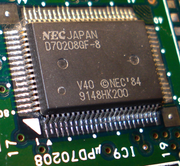- NEC V20
-
The NEC V20 (μPD70108) was a processor made by NEC that was a reverse-engineered, pin-compatible version of the Intel 8088 with an instruction set compatible with the Intel 80186. The chip featured approximately 29,000 transistors, ran at 8 to 16 MHz and was around 30% faster (application dependent) than the 8088 at the same clock speed, primarily due to a hardware multiplier (whereas the 8088 had to perform multiplication using a microcode program). NEC V20 was used in "turbo" versions of some PC clones such as Commodore PC compatible systems, Copam, and Tandy 1110 laptop series. It was also used in the Casio PV-S450 PDA and Hewlett-Packard's HP 95LX. Sony also produced this microprocessor under license from NEC as the V20H (Sony CXQ70108).
An unusual feature of the NEC V20 was that it added an Intel 8080 emulation mode, in which it could execute programs written for the Intel 8080 processors. The instructions
BRKEMexecuted in 8086 mode (NEC used a different notation for the instructions than Intel and BRK in NEC notation = INT in Intel notation) andRETEMandCALLNexecuted in 8080 mode was used to switch or return to or from the emulation mode. There was a V2080 CPMulator program which allowed to run 8080-based CP/M-80 programs on a MS-DOS machine.The NEC V30 (μPD70116) was a version of the NEC V20 that was pin compatible with the 16-bit data bus Intel 8086 processor. It too supported the 8080 emulation mode. The V30 was used in the GTD-5 EAX Class 5 central office as a drop-in performance upgrade for the processor complex in the late 1980s. It was also used in the Psion Series 3, in the NEC PC-9801, the Olivetti PCS86, the Applied Engineering "PC Transporter" emulator for the Apple II series of computers, and in various arcade machines (particularly ones made by Irem) in the late 1980s.
The NEC V20HL (μPD70108H) and NEC V30HL (μPD70116H) were a high-speed (up to 16MHz) and low-power versions.
The NEC V25 is the microcontroller version of the NEC V20 processor.
The NEC V33 is a super version of the V30 that separates address bus and data bus, and executes all instructions with wired logic instead of micro-codes, making it twice as fast as a V30 for the same clock frequency. V33 has the performance equivalent to Intel 80286. NEC V33 offers a method to expanding the memory address space to 16M bytes. It has two additional instructions
BRKXAandRETXAto support extended addressing mode. The 8080 emulation mode was not supported.The NEC V33A (μPD70136A) differs from the NEC V33 in that it has interrupt vector numbers compatible with intel 80X86 processors.
NEC V40 (μPD70208) embedded version of V20, integrated Intel-compatible 8251 USART, 8253 programmable interval timer, and 8255 parallel port interface. Used in the Olivetti PC1.
NEC V50 (μPD70216) embedded version of V30 with 16-bit data bus.
The NEC V41 (μPD70270) NEC V51 (μPD70280) integrated V30HL core and PC-XT peripherals: 8255 parallel port interface, 8254 programmable interval timer, 8259 PIC, 8237 DMA controller and 8042 keyboard controller. Also integrates full DRAM controller. Was used in Olivetti Quaderno XT-20.
The NEC V53 (μPD70236) integrates a V33 core with 4-channel DMA (μPD71087/i8237), UART (μPD71051/i8251), three timer/counters (μPD71054/i8254) and interrupt controller (μPD71059/i8259).
The NEC V53A (μPD70236A) integrates some peripherals with a V33A core.
The Vadem VG230 was a single-chip PC platform. The VG230 contained a 16 MHz NEC V30HL processor and IBM PC/XT-compatible core logic, LCD controller (CGA/AT&T640x400) with touch-plane supprt, keyboard matrix scanner, dual PCMCIA 2.1 card controller, EMS 4.0 hardware support for up to 64 MB, and built-in timer, PIC, DMA, UART and RTC controllers. It was used in the HP OmniGo 100 and 120.
The enhanced Vadem VG330 contained a 32 MHz NEC V30MX processor and IBM PC/AT-compatible core logic with dual PICs, LCD controller (640x480), keyboard matrix scanner, PC Card ExCA 2.1 controller and SIR port.
Starting with the NEC V60, NEC departed from the x86 design.
See also
External links

This computer hardware article is a stub. You can help Wikipedia by expanding it.




